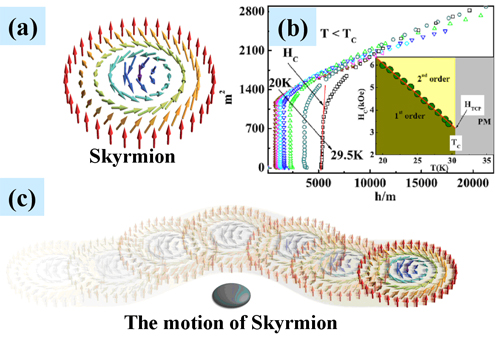New progress is achieved in the Skyrmion materials by the research group of the High Magnetic Field Laboratory (CHMFL). They perform studies on the Skyrmion material MnSi, and find the tricritical behavior in the Skyrmion material MnSi. In addition, they proof that the magnetic interaction of this system belongs to the long range interaction, and give the decay distance of the spin interaction.
Due to fascinating physical phenomena such as the weak itinerant ferromagnetism, the non-Fermi liquid behavior, and the quantum phase transition, the helimagnet MnSi is always the focus of the scientists. Recently, this material is paid renewed attention because of the discovery of the Skyrmion phase in this system. The Skyrmion is a vortex spin texture (see Figure 1), which has great potential application in the spintronics due to its topological property, nanometric size, and lower-current-driven motion. Therefore, the research on the concerning materials becomes very important at present.
Researchers in High Magnetic Field Laboratoey,CAS perform detailed study on the critical behavior of the Skymion material MnSi. By carefully measuring, fitting, and calculating the magnetic behavior on the critical point, the reliable critical exponents are achieved, which shows that the MnSi exhibits a tricritcial phenomenon at the critical point. Tricritcial phenomenon is usually located at the single point where three physical phases meet on the phase diagram. After carefully study, it is found that the critical point of MnSi is induced by the external magnetic field. Under the external magnetic field, the first-order phase transition in MnSi is rapidly suppressed into the second-order one, which results into the appearance of the tricritical point. It is found that the tricritical point is induced by an applied of external magnetic field of 3200 Oe. Moreover, the researcher proofs that the spin interaction in MnSi belongs to the long-rang interaction, which gives the decay distance of J(r) ≈ r−4.3. This research paper was published in Physical Review B of the American Physical Society.
The paper linkage: http://link.aps.org/doi/10.1103/PhysRevB.91.024403
